Apple Honey Challah is one of my most popular Rosh Hashanah recipes. This beautiful braided challah is sweetened with honey and stuffed with tender apple pieces. I have included easy braiding instructions for a perfect round challah every time.

Rosh Hashanah is fast approaching. What better way to celebrate than with a freshly baked Apple Honey Challah? On Rosh Hashanah we dip apples in honey to symbolize our hope for a sweet new year. In this recipe, the apple and honey tradition is incorporated into my Shabbat challah recipe. It has become a holiday tradition for many readers and their families.
The Rosh Hashanah tradition is to braid challah in a round shape for the holiday. Some believe the round shape represents a crown for God. Our family tradition says that the circular shape represents the cyclical nature of the year– as one year draws to a close, another year begins, and so the circle continues. There are many ways to make a round challah. In this post, I’ll be sharing a braiding technique that was first introduced to me by my blogging friend Andrea at Capitol to Capital. It creates a lovely challah with a very pretty design on the top. I’ve broken it down in step-by-step instructions for you; it seems complicated at first, but once you get the hang of it you’ll realize it’s actually pretty easy.
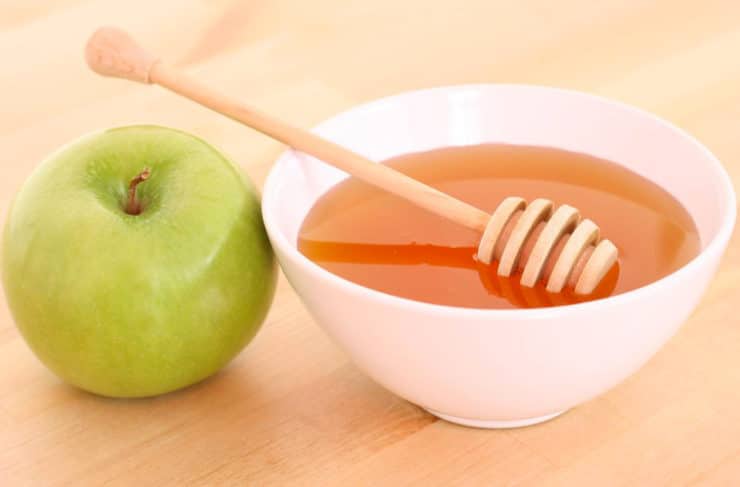
I wanted this challah to be sweet, but not dessert-sweet. I gave it a sweetness level similar to Hawaiian bread, so it could be served and enjoyed with dinner. You can sweeten it further by topping it with honey… and with butter, if you’re so inclined. The recipe is dairy free so it can be served with a meat meal, but I’ve gotta say it’s awesome topped with salted butter and honey. Holy moly. Good stuff!
The apples were a challenge at first. I used Granny Smith, which are naturally tart but best for baking. In the beginning, the apples weren’t baking up sweet enough for my taste. I solved this by tossing them in sugar before integrating them into the challah. You can add a little cinnamon to the apples, too, if you’d like an apple-cinnamon flavor. With the sugar, they ended up adding a soft, moist bit of sweetness to the dough– just right!
If you’ve never made challah before, I don’t recommend starting with this one. Working with challah dough is something that becomes considerably easier with time and experience. Rather than working the apples into the dough during kneading, I’ve found that concealing the apples in the strand creates a more even, smooth shape to the braid.
Making these stuffed strands is not a complicated process, but it might be frustrating to somebody who has never worked with challah dough before. If you’re new to challah, I recommend simply making this into a Honey Challah by omitting the apples. You can then make regular strands instead of stuffed ones, and you can choose any braiding technique you like. There are several easy braiding methods, including a simple 3-strand or 4-strand braid, or a Linked Loops braid for a round Rosh Hashanah challah. For an introduction to the basic braiding techniques, click here.
For those who don’t want to bother with braiding and aren’t worried about making a round shaped challah, you can try a Royal Challah pan, which will create a beautifully shaped challah without the need to braid. If you’re comfortable with challah and you’re up for the challenge, read on! It’s really not that difficult, especially since I’ve broken each step down with photos to illustrate.
Here is a printable diagram that you can bring into the kitchen to keep you on track as you braid. Once you do it a couple of times, you’ll realize it’s a very simple braid to master:
How to Braid a Four Strand Round Challah
This challah smells AMAZING while it’s baking. It has the aroma and flavor of the holiday. Topping it with turbinado sugar gives an extra bit of crunchy sweetness to the crust. Shana Tova!
Recommended Products:
We are a participant in the Amazon Services LLC Associates Program, an affiliate advertising program designed to provide a means for us to earn fees by linking to Amazon.com and affiliated sites. As an Amazon Associate I earn from qualifying purchases.

Apple Honey Challah
Ingredients
Dough Ingredients
- 1 1/2 cups lukewarm water, divided
- 1/4 ounces active dry yeast
- 1 teaspoon sugar
- 1 large egg
- 3 large egg yolks
- 3/4 cup honey
- 2 tablespoons avocado oil (or canola - avocado oil is healthier)
- 2 teaspoons vanilla
- 2 teaspoons salt
- 5-7 cups flour
- 3 medium granny smith apples
- 1/4 cup sugar
- 2 tablespoons turbinado sugar (optional)
Egg Wash Ingredients
- 1 large egg
- 1 tablespoon cold water
- 1/2 teaspoon salt
NOTES
Instructions
- Pour ¼ cup of the lukewarm water (about 110 degrees) into a large mixing bowl. Add 1 packet of Active Dry Yeast and 1 tsp of sugar to the bowl, whisk to dissolve. Wait 10 minutes. The yeast should have activated, meaning it will look expanded and foamy. If it doesn’t, your yeast may have expired, which means your bread won’t rise—go buy some fresh yeast!

- Once your yeast has activated, add remaining 1 ¼ cup lukewarm water to the bowl along with the egg, egg yolks, honey, canola oil, vanilla and salt. Use a whisk to thoroughly blend the ingredients together.

- Begin adding the flour to the bowl by half-cupfuls, stirring with a large spoon each time flour is added. When mixture becomes too thick to stir, use your hands to knead.

- Continue to add flour and knead the dough until it’s smooth, elastic, and not sticky. The amount of flour you will need to achieve this texture varies—only add flour until the dough feels pliable and “right.” Turn the dough out onto a smooth surface and knead a few more times.

- Place a saucepan full of water on the stove to boil.

- Wash out the mixing bowl that you used to mix the challah dough. Grease the bowl with canola oil. Push the dough back into the bottom of the bowl, then flip it over so that both sides are slightly moistened by the oil.

- Cover the bowl with a clean, damp kitchen towel. Place the bowl of dough on the middle rack of your oven. Take the saucepan full of boiling water and place it below the rack where your dough sits. Close the oven, but do not turn it on. The pan of hot water will create a warm, moist environment for your dough to rise. Let the dough rise for 1 hour.

- Take the dough bowl out and punch it down several times to remove air pockets. Place it back inside the oven and let it rise for 1 hour longer.During this final rise, fill a mixing bowl with cold water and dissolve ½ tsp of salt in it. Peel the apples and dice them into very small pieces, about ¼ inch large. Place the diced apples into the bowl of lightly salted water. Reserve. When you are ready to begin braiding the dough, drain the apple pieces and pat them dry with paper towels. Toss the apple pieces with 1/4 cup of sugar. If you’d like, you can add ½ tsp of cinnamon to the sugar to give the apples an apple-cinnamon flavor.

- Take the dough out of the oven; it should have doubled in size during this final rise. If it has not fully risen, return it to the oven till it's had a chance to properly rise. When the dough is ready, flour a smooth surface like a cutting board. Punch the dough down into the bowl a few times, then turn the dough out onto the floured surface. Knead the dough a bit, adding flour as needed to keep it from feeling sticky. You will have enough dough for two medium-sized challot (challahs).

- Divide the dough into two equal halves. Put one half of the dough on a smooth, lightly floured surface. Leave the other half of the dough in the bowl covered by a moist towel. Cut the dough on the floured surface into four equal portions.

- Take one of the four portions and stretch it with your fingers into a rough rectangle, about 1 foot long and 3-4 inches wide. Use a rolling pin to smooth the dough, if it helps. The rectangle doesn’t need to look perfect, and it shouldn't be too thin-- the dough needs to be thick enough to handle an apple filling.

- Sprinkle some of the sugared apple pieces across the center of the rectangle. You should use about 1/8 of the apple pieces in each rectangle. Liquid will collect in the apple bowl as you progress—do not transfer the liquid to the dough, or it will weaken and become mushy. Do your best to shake off excess liquid before placing the apples on the dough. Leave at least 1/2 inch border along the outer edge of the dough clean, with no apples.

- Gently roll the upper edge of the rectangle down to the lower edge and pinch to seal, creating a snake-like roll of dough stuffed with apples. This is the beginning of your strand.

- Gently and carefully roll the stuffed strand till it becomes smooth, using gentle pressure with your hands on the center of the strand, pulling outward as you roll. If any apples begin to poke through the dough, repair the hole with your fingers before you continue. Re-flour the surface as needed to keep your dough from sticking.

- Taper the ends of the strand by clasping between both palms and rolling. At the end of the rolling process, your strand should be about 16 to 18 inches long with tapered ends.Once your apple strand has been rolled, repeat the process with the remaining 3 pieces of dough, making sure that they are even in length with the first strand. In the end, you’ll have 4 apple-stuffed strands.

- Now your stuffed strands are ready to braid. There are a few different ways to braid 4 strands into a challah. This recipe will guide you through one method for braiding a round four strand challah. For other braiding methods, click here.Place two strands in the center of a smooth surface, running parallel top to bottom. Place the third strand across the two strands, going under the left strand and over the right. Place the fourth strand directly below the third strand, going over the left strand and under the right. You will have something similar to a tic-tac-toe board pattern, with the center of the board being a very small square and 8 “legs” sticking out from that center. Keep the center as tight as possible… you’ll be braiding from the center. I have numbered the strand ends in the following diagram to make the braiding process easier.

- Take strand 1 and cross it over strand 2.

- Take strand 3 and cross it over strand 4.

- Take strand 5 and cross it over strand 6.

- Take strand 7 and cross it over strand 8.

- Take strand 2 and cross it back the opposite way, over strand 7.

- Take strand 8 and cross it over strand 5.

- Take strand 6 and cross it over strand 3.

- Take strand 4 and cross it over strand 1.

- Take strand 7 and twist it with strand 4.

- Tuck the twisted ends under the challah.

- Repeat this process with the remaining loose ends—twist and tuck 1 with 6, then 3 and 8, then 5 and 2.

- When all of the loose ends are twisted under, gently plump the challah into a nice, even round shape.

- After the round has been braided, place it on a baking sheet lined with parchment paper. Preheat the oven to 350 degrees F. Let the braid rise 30 to 45 minutes longer. You’ll know the dough is ready to bake when you press your finger into the dough and the indentation stays, rather than bouncing back. While this challah rises, you can braid the other half of the dough in the same way, or you might choose a different braid for your second challah. No matter which way you braid, you can conceal the apple pieces inside the strands using the same method described above. Your second challah will rise as the first one bakes.

- Prepare your egg wash by beating the egg, salt and water till smooth. Use a pastry brush to brush a thin layer of the mixture onto the visible surface of your challah. Reserve the leftover egg wash. Sprinkle the top of the challah with 1 tbsp turbinado sugar, if you wish.Each challah needs to bake for about 45 minutes total, but to get the best result the baking should be done in stages. First, set your timer to 20 minutes and put your challah in the oven.After 20 minutes, take the challah out of the oven and coat the grooves of the braid with another thin layer of egg wash. These areas tend to expand during baking, exposing dough that will turn white unless they are coated with egg wash. Turn the challah around, so the opposite side faces front, and put it back into the oven. Turning it will help your challah brown evenly—the back of the oven is usually hotter than the front.The challah will need to bake for about 20 minutes longer. For this last part of the baking process, keep an eye on your challah—it may be browning faster than it's baking. Once the challah is browned to your liking, take it out and tent it with foil, then place it back in the oven. Remove the foil for the last 2 minutes of baking time.Take the challah out of the oven. At this point your house should smell delicious. Test the bread for doneness by turning it over and tapping on the bottom of the loaf—if it makes a hollow sound, and it's golden brown all the way across, it’s done. Because of the apples in this challah, it may take a bit longer to bake than your regular challah recipe. Err on the side of letting it cook longer to make sure it's baked all the way through. You can also stick an instant read thermometer in the thickest part of the challah-- when it reads 190, it is baked all the way through. Let challah cool completely on a wire cooling rack before serving. Bake the second challah in the same way.


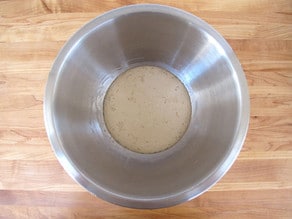
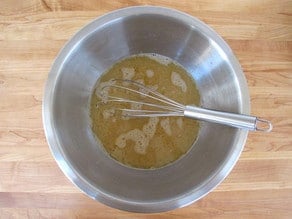
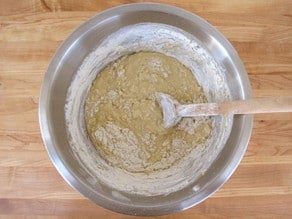

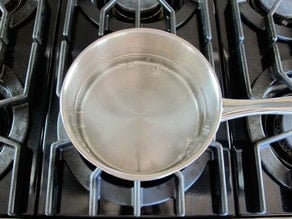
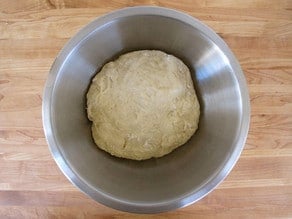
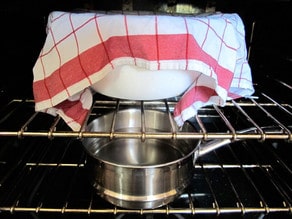














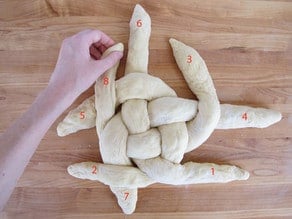


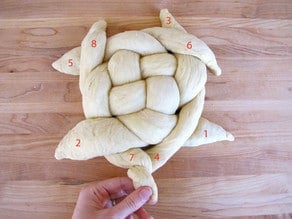
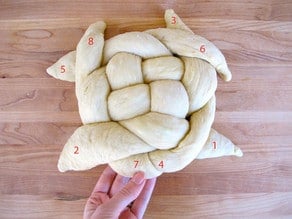




Tori,
You are a rock star! I just got my honey apple challah out of the oven, it is HUGE! Thank you! Your instructions were perfect! With the 2nd dough, it was so tired (What a drag it is getting old, thank you, Rolling Stones!), I did a three braid the same way as the crown. Worked perfectly! I had a couple openings as I was braiding, but plugged them up fast, lol.
Shana Tova to you and your family!
So happy to hear this worked out great for you, Christine!
Hello! I’ve made this recipe for a few years now for Rosh Hashanah and it’s always a huge hit! Two questions:
1. It has been coming out a bit dense. What am I doing wrong? Too much flour? Too much kneading?
2. Would it still work if I swapped AP flour for white whole wheat?
Thanks!
Sarah
Hi Sarah. Too much flour and/or too much kneading can both be reasons for an overly dense challah. You might also need to let it rise a bit more than you have been, and braid it a bit less tightly. As for the swap you suggested, that can actually make the bread more dense – so I would troubleshoot the density issue first, before making any other changes. Good luck!
Tori –
I am an experienced challah baker looking for an apple challah recipe for RH. I tried your recipe as written. I generally err on the side of less flour, so when you said 5 – 7 cups, I used six. I also use a blend of all purpose and bread flour. My yield was a little low – 3.5 pounds of dough, for whatever reason, so I had enough for a 2 pound 4 braid round and a smaller which I did “turbin” style. My apple pieces were more irregular than your photos (such is the challenge in chopping when you are tired after a long day). As a result my “logs” were a little messy. I also like to put a little cinnamon and cardemom in the dough for flavor. For the apples, I used a “spicey” sugar recipe from another cookbook to flavor them us (basically, sugar, cinnamon, nutmeg, allspice, mace – gives apples a lot of zip). My only comment is that I would prefer to use more water for the yeast starter, and not reserve most of the water off. Maybe more yeast too. Most challah recipes that yield 4 plus pounds of dough seem to use more yeast and sugar, and all the water, for the starter. Otherwise, nice recipe! Also liked using the oven and water for a proofer, and pulling the challah out of the oven after 15 minutes to redo the egg wash to minimize the braids tearing. I also measured the temperature and kept them in the oven to 190 degrees. Thanks for those ideas. I would attach photos but not sure how to do that.
This is a great recipe. I made it with my 8 year old grandson. Challah is one of his favorite things to make with me. Also everyone in his family loves when I visit and we make challah. We normally made the other recipe but always wanted to try this one. I finally got my grandson to agree and I know this challah recipe will be in the rotation. I’m proud that we were able to do the Apple stuffed braids together. Thanks for these wonderful recipes which allow me to share my Jewish heritage just like my grandmothers did with me growing up. Blessings to you and your family.
It is my first time making challah or braiding anything including hair 🙂 I’m an experienced baker but not with brioche. Well this has been a resounding success for me! I followed your instructions for braiding and I was really patient with the rising dough. I can’t believe I made such a gorgeous challah. You are a very talented teacher because all your steps were clear and well explained. I shaped the second loaf in a 4 braid challah also following your instructions. Thank you so much for posting. You are now my go-to for all things challah!
Smiling from ear to ear. When I was in fourth grade, my teacher did a unit on explaining things clearly step-by-step. We had to teach our other classmates how to complete a task with verbal instructions only. It stuck with me. Glad it paid off, these many years later!
everything went perfectly …..until the apples. UGH!!!! I’m sure it will be delicious, but it looks terrible—still in the 3rd rise, but nothing is rising. And dinner is in 90 minutes!
It’s me….I have the opposite of the magic touch when it comes to baking!
L’shana tovah!!
Don’t be too hard on yourself Lisa, this is a big project and it takes some practice to get it right! It took me a while master challah, too. 🙂 Hang in there, and I hope it tastes great regardless!
Hi, Tori,
If letting the dough rise in the refrigerator,can you assume it is ready to bake the following day?; in other words, is 24 hours okay,and is there a way to test it? Also, can the apples be prepared the day before, and left in the refrigerator(in water)? Thanks so much!
Hi Beth, since fridges and dough batches vary so greatly, it’s hard to know – I would take it out and test it by pushing a finger into the dough. If it bounces right back, it needs to rise a bit more. If the indentation stays and doesn’t bounce right back, it’s risen enough and ready to bake. Good luck!
Two questions:
1: can I use my kitchen aide, and how would I adapt? I’m recovering from a broken wrist, and find it difficult to get enough strength to knead long enough.
2: can I freeze one challah after braiding, athen defrost for rising and baking at Yom Kippur?
This looks like a delicious sweet challah, like my mom’s! Unfortunately, she took her recipe with her, and I’ve been searching for a sub for a while!
Thanks
You can use the kneading attachment/feature on your mixer to knead the dough, no problem. Just take care not to over-knead – remove the dough as soon as it comes together smoothly. As for freezing, I generally prefer to freeze challah after its baked rather than before, for best flavor results. If you really want to freeze the dough, you can freeze it after braiding. Don’t let the brain rise before you freeze – the hope is that when the dough defrosts, it will rise at that time, before you bake it. But that doesn’t always work out the way you’d hope, which is why I recommend freezing them fully baked. If you’re freezing it fully baked, I would not add the sugar finish to the egg wash, as it tends to dissolve and weep when the challah defrosts. Good luck!
Hi, Tori,
Can I make this the day before, and, if so, should it be refrigerated (after being cooled and tightly wrapped)? Thanks so much; Shana Tova!
– Beth
Hi Beth! Yes you can make it a day ahead. If refrigerating it, be sure to cool completely, cover tightly, and omit the sugar topping (the condensation from refrigeration can cause it to weep).